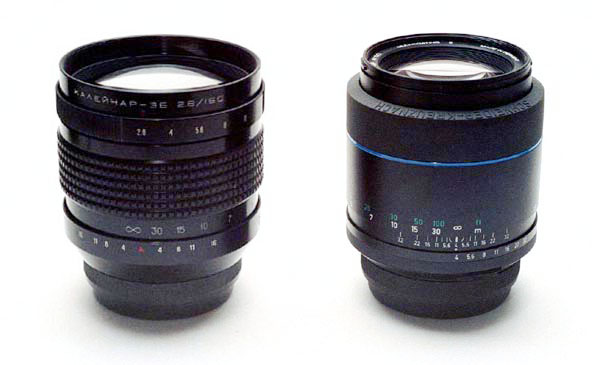
[C306-32: Two 150mm lenses in P6 mounts: the f/2.8 Arsenal
Kaleinar
(l) and the f/4 Schneider Tele-Xenar (r)]
150-180mm
150mm

[C306-32: Two 150mm lenses in P6 mounts: the f/2.8 Arsenal
Kaleinar
(l) and the f/4 Schneider Tele-Xenar (r)]
The f/4 150mm Joseph
Schneider Tele-Xenar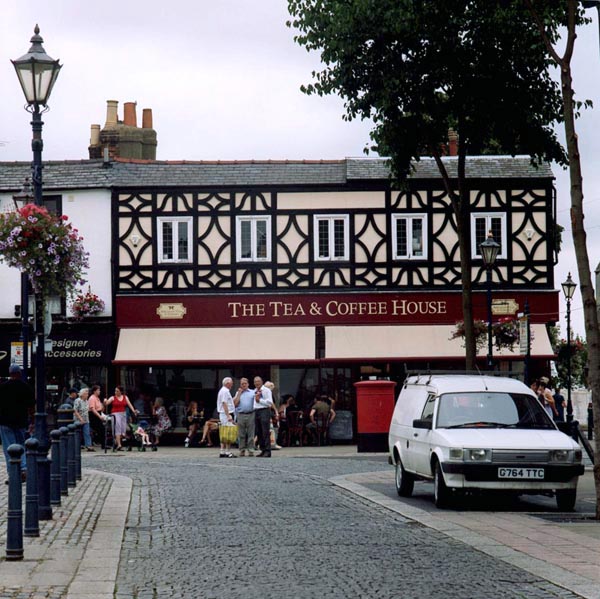 [C297-11/12: 150mm Tele-Xenar at f/11
1/125]
|
The f/4 150mm Joseph Schneider Tele-Xenar lens is beautifully made, and lightweight for the format and focal length (760 grams according to the literature, although I haven’t weighed it). It also takes 67mm filters, like most of the Exakta 66 Schneider lenses – and of course it couples with the Exakta 66 TTL prism. Optically, it is outstanding. It produces images that are acceptably sharp to the edge of the frame even at full aperture (f/4). Stopping down to f/11 results in a noticeable increase in sharpness and contrast across the whole of the image. |
|
The f/2.8 150mm Kiev
Arsenal Kaleinar In comparison, the f/2.8 150mm Kaleinar is quite soft at maximum aperture, but perhaps this is an unfair comparison. At f/4, the whole image is virtually as sharp as the Tele-Xenar. From f/5.6, the Kaleinar looks as sharp to me as the Tele-Xenar (at f/4), in 8 × 8 inch colour prints. At f/11, I cannot distinguish (even with the loupe) between the Tele-Xenar and the Kaleinar shots. Since my Kaleinar was manufactured in 1982, is not multi-coated and seems to have had a bit of a rough life, this is very pleasing. The maximum aperture of the Tele-Xenar is f/4, while the maximum aperture of the Kaleinar is f/2.8, so there might be low-light situations where you would not even get a steady hand-held shot with the Tele-Xenar, but would with the Kaleinar. And the Kaleinar gives you a viewfinder image that is twice as bright as the Tele-Xenar, whatever the aperture you are using. The “price” of the faster aperture on the Kaleinar is a
much larger
and heavier lens (1,100 grams, according to the
literature) and the need
for the larger 82mm filters. Also, there is of course no
connection to
the Exakta 66 TTL meter (should one need it). My Kaleinar
came without
a lens shade, whereas my Tele-Xenar came with one.
However, a lens
shade was made for this lens, although it seems to be
quite rare.
I was eventually able to buy one, but not in time to use
it for these tests
This method really takes less time to do than to
describe, but now I hit a problem: This lens does
not have a stop-down lever for checking depth of field and
for metering! So I had to use aperture-priority
metering:
Doing all of this is much slower than using my stop-down
metering method. The perspective given by this lens
results in a picture that I find quite pleasing – but it
was a good thing that the subject wasn’t moving! |
|
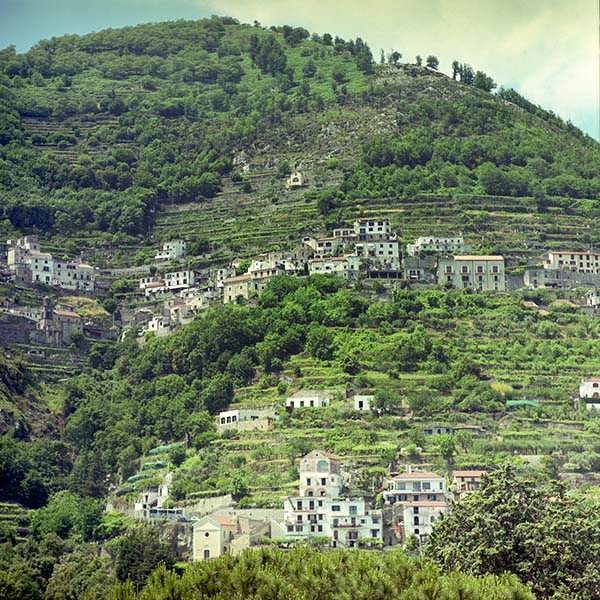 [C552_3.jpg]
|
For links to the pages on this website on the various metering methods and links to my videos on them, please visit the Instructions page here. For an explanation of depth of field, see here. For examples of differential focus, and explanations, see here and here. |
||
|
The 75-150mm Joseph Schneider
Variogon at 150mm You can see a report on the 150mm Hartblei lens here. |
160mm
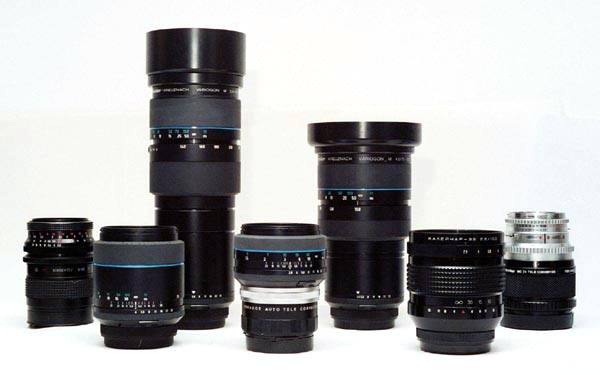 [C306-36/E(37): 150-160mm From left to
right: 80mm CZJ Biometar in
P6 finish with Arsenal 2× converter, 150mm Schneider
Tele-Xenar,
140-280mm Schneider Variogon, here set to 150mm, CZJ
Biometar “III” in
Exakta 66 finish with Panagor 2× converter, 75-150mm
Schneider Variogon
set to 150mm, 150mm Arsenal Kaleinar, 80mm Carl Zeiss
Oberkochen Planar
with Vivitar 2× converter in Hasselblad mount.]
|
|
This focal length results from using the standard lens with a 2× converter. As this is a cheaper and light-weight alternative to owning a 150mm/180mm lens, it is worth considering. In all cases, the effective maximum aperture is f/5.6. In the description that follows, the apertures given are those set on the prime lens. 160mm is an excellent focal length for portraits, but what is the quality like? (Of course, with portraits lack of sharpness at the edges and corners might be quite acceptable; but for this test, we are being much more demanding.) Well, here comes the first major disappointment.
I coupled the
Biometar
III with the Panagor 2× converter.
At f/2.8 the
softness across most of the frame apart from a small
area in the centre
is incredible. Perhaps fine for a “dreamy”
romantic portrait shot.
But unusable at this aperture for just about anything
else.
At f/11, the image has of course sharpened up considerably, but it is nowhere near the 150mm lenses and the 75-150 at this aperture, and there is a lack of contrast – almost flare – pretty near to the centre of the image. My tests of the Biometar showed that this lens yields excellent results, so the problem must be caused by the converter. Using the Panagor with the Pentacon Six multi-coated Biometar (“Mk II”) resulted in virtually identical results, not surprisingly. Now I put the Arsenal converter on the Mk II Biometar. What a contrast! Even with f/2.8 on the prime lens, the results are quite acceptable. With the prime lens set to f/11, there is still a difference between this combination and the excellent 150mm Tele-Xenar at the same aperture, but you’d need a loupe and very good light to see it. Of course, with f/11 set on this lens, the light reaching the film through the converter is equivalent to f/22, so we are talking very slow shutter speeds here (in my test shots, 1/30 sec, as against 1/125 with the Tele-Xenar).
Finally, I tested the Vivitar 2× converter with the Carl Zeiss Oberkochen Planar. At f/2.8, the image is marginally sharper than the Arsenal/Biometar combination, with a slightly sharper image and significantly more contrast. At f/11 there is a further slight improvement in the sharpness on the roof tiles at the edge of the picture, compared with the same combination at full aperture. How does this compare with the Arsenal/Biometar combination at f/11? With the naked eye I cannot see a difference. With the loupe, perhaps the Vivitar/Planar win by a whisker, perhaps not. Since the Biometar came out handsomely on its own against the Planar, any difference here is down to the converters. The Vivitar is clearly outstanding (but it won’t fit your Pentacon-Six!), and the Arsenal converter is very close behind. “What about the Schneider 2× converter?” I hear you cry. Well, as indicated above, this converter can’t be matched with lenses shorter than 150mm, so we’ll have to wait until we get to them to see how it performs.
|
180mm
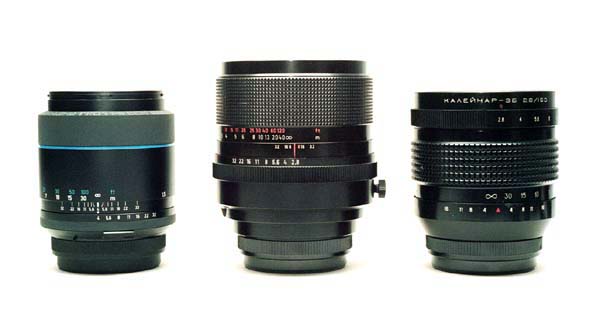
[C308-2: The 180mm f/2.8 Carl Zeiss Jena Sonnar in the middle,
with
the 150mm f/4 Schneider Tele-Xenar on its left and the 150mm
f/2.8 Arsenal
Kaleinar on its right.]
|
A very short step takes us to the 180mm Carl Zeiss Jena Sonnar. This lens is MUCH sharper than the 150mm Arsenal Kaleinar. Both are f/2.8 lenses, and the Kaleinar is VERY soft at maximum aperture, whereas the Sonnar is still very sharp. In fact, the Sonnar’s results at f/2.8 are really quite outstanding, and while there is a slight increase in contrast at f/11, when you start off this good, there is little more that is gainable when stopping down, other than the obvious increase in depth of field. Although not required for this test shot, the 180mm Sonnar also focusses a LOT closer than the 150mm Kaleinar, making it ideal for head-and-shoulders portraits, whereas the Kaleinar can’t get quite close enough, unless a short extension tube is used. With a lens as sharp as the Sonnar, a soft-focus filter could be useful for at least female portraits.
|
To go back to the beginning of the lens tests, click below and
then
choose the focal length that you want to read about.
Back to beginning of lens tests
© TRA January 2002 Latest revision: October 2017